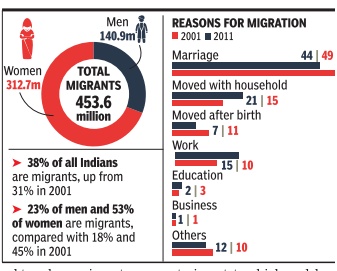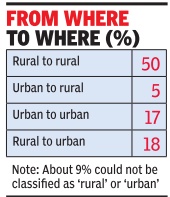Migration: India
This is a collection of articles archived for the excellence of their content. |
Internal migration
40% Indians migrants; mainly for marriage
Subodh Varma, 4 of 10 Indians migrants, most move for marriage, Dec 2, 2016: The Times of India


Nearly two out of five Indians -some 454 mil lion in all -are migrants, having left their place of residence and settled down somewhere else, according to fresh Census 2011 data on migration released on Thursday . Between 2001 and 2011, 139 million Indians migrated within the country . The vast majority of migrants, 69%, are women moving out of their parental homes to stay with their husbands in their native homes, or perhaps migrate with them elsewhere.
Half of this massive movement of humanity is taking place within rural areas -rural-to-rural migration.Rural-to-urban migration makes up about 18% while urban-to-urban is another 17%. In 2001, the share of ru ral-to-urban migrants was about 17%, indicating that there has not been a big shift in the percentage of people moving from villages to cities during the 2001-2011decade over the 1991-2001decade.
This complements the earlier data given by the census that the urban growth ra te is not too high and has slackened in many cities.
Among the reasons cited for migration by those surveyed, about 10% moved in search of employment during the decade ending 2011, down from 15% in 2001. This is counterintuiti ve, considering the po pular belief that mig ration is primarily driven by work.The share of those moving to pursue education makes up only 2% of migrants, down from 3% recorded in the 2001 census.
Marria ge remains the biggest cause for migration, accounting for 49%, up from 44% in 2001. The census questionnaire includes a reason de signated as “moved after birth“, which is mainly children being born in a pla ce -the mothers' village or a nearby town with hospital -and then moving back home to the parental ho use. This share has in 7% creased from in 2001 to 11%More in 2011.
than a fifth of all migrants had said in 2001 that the reason for migrating was that their fa mily was moving. They wo uld be dependents, both yo ung and old. This share has declined to 15% in 2011.